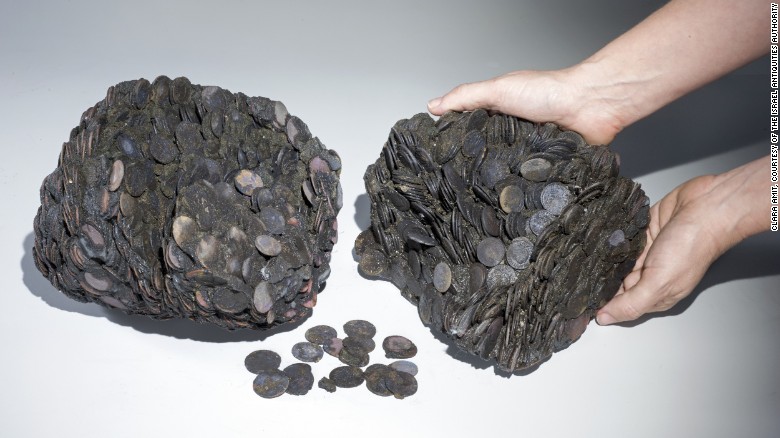Posted May 27, 2016 by Martin Armstrong
 An ancient Roman shipwreck has been discovered in the port of ancient Caesarea, located in Israel. The ship was full of bronze statues and coins that were destined to be melted down. The coins are from Constantine (309-337AD) and Licinius (308-324 AD). The typical bronze Follis of this period weighed 6.5 grams on average. By the end of the century, bronze coins were reduced to under 2 grams.
An ancient Roman shipwreck has been discovered in the port of ancient Caesarea, located in Israel. The ship was full of bronze statues and coins that were destined to be melted down. The coins are from Constantine (309-337AD) and Licinius (308-324 AD). The typical bronze Follis of this period weighed 6.5 grams on average. By the end of the century, bronze coins were reduced to under 2 grams. Shipwrecks like this are rare and typically the main source of bronze objects since most would have been melted down. The Vandals sacked Rome, and, to this day, we retain the word “vandalize” because they ripped the copper off the roofs of every temple. Even bronze went through cycles of abundance and periods of scarcity. There is a cycle to everything.
Shipwrecks like this are rare and typically the main source of bronze objects since most would have been melted down. The Vandals sacked Rome, and, to this day, we retain the word “vandalize” because they ripped the copper off the roofs of every temple. Even bronze went through cycles of abundance and periods of scarcity. There is a cycle to everything. There was an attempt to restore the bronze coinage under Constans in 348 AD, and again under Julian II in 362 AD. As the empire began to spiral down, the coinage became gold and silver. Bronze was hoarded because it had a utilitarian value and could be recast into weapons or tools. The 4th century finds bronze all but vanish and gold becomes the common means of a medium of exchange until the empire collapses altogether in 476AD.
There was an attempt to restore the bronze coinage under Constans in 348 AD, and again under Julian II in 362 AD. As the empire began to spiral down, the coinage became gold and silver. Bronze was hoarded because it had a utilitarian value and could be recast into weapons or tools. The 4th century finds bronze all but vanish and gold becomes the common means of a medium of exchange until the empire collapses altogether in 476AD.
Even after the fall of Rome, we find the coinage is virtually only gold. The Merovingian coinage is gold, and the same is true in the Celtic coinage. This eventually gives way and gold vanished for 600 years. The Dark Age produced some coinage, but they are rarely found more than 20 miles from where they were struck, which confirms the lack of trade. The coinage simply became silver.

We can even see the debasement of gold being replaced with silver in the coinage of the Anglo-Saxons. The silver denarius of Rome was revived and became the silver penny in Britain. Offa (757-796 AD) even issued coins with his wife’s portrait. This is a direct restoration of the Roman monetary system that always issued coins showing the first lady so to speak.



No comments:
Post a Comment